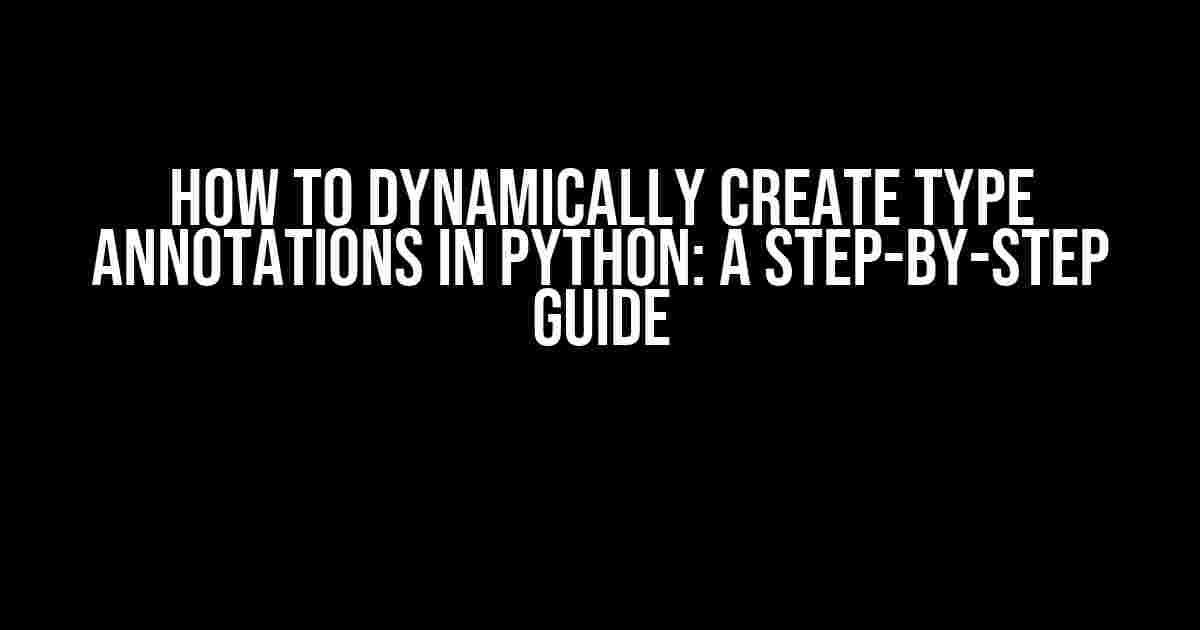Are you tired of tedious type annotations in Python? Do you want to take your code to the next level by dynamically creating type hints? Look no further! In this comprehensive guide, we’ll show you how to dynamically create type annotations in Python, revolutionizing the way you write code.
What are Type Annotations in Python?
Before we dive into the juicy stuff, let’s quickly review what type annotations are in Python. Type annotations are a way to add type hints to your code, making it easier for developers and tools to understand the structure of your code. They’re optional, but highly recommended, as they improve code readability and help catch type-related errors.
def greet(name: str) -> None:
print(f"Hello, {name}!")
In the example above, we’ve added type annotations to the `greet` function, indicating that the `name` parameter should be a string and the function returns no value (i.e., `None`).
Why Dynamically Create Type Annotations?
So, why would you want to dynamically create type annotations in Python? There are several reasons:
- Faster Development**: By automating type annotation creation, you can focus on writing code rather than tediously adding type hints.
- Improved Code Quality**: Dynamically generated type annotations ensure consistency and accuracy, reducing the likelihood of errors.
- Better Code Readability**: Clear and concise type annotations make your code easier to understand and maintain.
Methods for Dynamically Creating Type Annotations
There are several ways to dynamically create type annotations in Python. We’ll explore two popular methods: using the `typing` module and leveraging Python’s built-in `__annotations__` attribute.
Method 1: Using the `typing` Module
The `typing` module, introduced in Python 3.5, provides a way to create type annotations programmatically. We can use the ` typing.TypeVar` and `typing.NewType` functions to define custom type aliases.
import typing
# Create a custom type alias for a string
MyString = typing.NewType('MyString', str)
# Define a function with dynamic type annotations
def greet(name: MyString) -> None:
print(f"Hello, {name}!")
# Create another custom type alias for an integer
MyInt = typing.TypeVar('MyInt', int)
# Define a function with dynamic type annotations
def add_numbers(a: MyInt, b: MyInt) -> MyInt:
return a + b
In the example above, we’ve created custom type aliases `MyString` and `MyInt` using the `NewType` and `TypeVar` functions from the `typing` module. We then used these aliases to define type annotations for our `greet` and `add_numbers` functions.
Method 2: Using the `__annotations__` Attribute
Python’s built-in `__annotations__` attribute provides a way to access and manipulate type annotations at runtime. We can use this attribute to dynamically create type annotations for our functions.
def add_numbers(a, b):
# Create type annotations dynamically
add_numbers.__annotations__ = {'a': int, 'b': int, 'return': int}
return a + b
print(add_numbers.__annotations__) # Output: {'a': , 'b': , 'return': }
In the example above, we’ve created a function `add_numbers` without initial type annotations. We then used the `__annotations__` attribute to dynamically add type annotations for the `a` and `b` parameters, as well as the return value.
Best Practices for Dynamically Creating Type Annotations
When dynamically creating type annotations, keep the following best practices in mind:
- Consistency is Key**: Ensure that your dynamically generated type annotations follow a consistent pattern and style throughout your codebase.
- Use Meaningful Type Aliases**: Choose clear and descriptive names for your custom type aliases to improve code readability.
- Test Thoroughly**: Verify that your dynamically created type annotations are accurate and functional by testing your code thoroughly.
- Document Your Code**: Clearly document your dynamically created type annotations to ensure that other developers understand the intent behind your code.
Conclusion
Dynamically creating type annotations in Python can revolutionize the way you write code. By using the `typing` module or Python’s built-in `__annotations__` attribute, you can automate type annotation creation, improving code quality, readability, and maintainability. Remember to follow best practices and test your code thoroughly to ensure accuracy and functionality.
| Method | Description | Example |
|---|---|---|
| Using the `typing` Module | Create custom type aliases using `typing.TypeVar` and `typing.NewType` | MyString = typing.NewType('MyString', str) |
| Using the `__annotations__` Attribute | Access and manipulate type annotations at runtime | add_numbers.__annotations__ = {'a': int, 'b': int, 'return': int} |
Now, go forth and dynamically create type annotations like a pro! 🚀
Frequently Asked Question
Get ready to unlock the secrets of dynamic type annotations in Python! Here are the top 5 questions and answers to help you master this powerful technique.
What is dynamic type annotation in Python, and why do I need it?
Dynamic type annotation in Python is a way to create type hints for variables, functions, or classes at runtime. You need it when you want to provide better code readability, enable static type checking, and improve code maintainability. It’s especially useful when working with complex data structures or third-party libraries.
How can I dynamically create type annotations using the `typing` module?
You can use the `typing.TypeVar` and `typing.NewType` functions to create dynamic type annotations. For example, you can create a type variable like this: `T = typing.TypeVar(‘T’)`, and then use it to annotate a function or variable. You can also use `typing.NewType` to create a new type alias at runtime.
Can I use dynamic type annotations with Python’s built-in data structures?
Yes, you can use dynamic type annotations with Python’s built-in data structures like lists, dictionaries, and sets. For example, you can create a type alias for a list of integers like this: `IntList = typing.List[int]`. You can then use this type alias to annotate a variable or function that expects a list of integers.
How do I dynamically add type annotations to a function or class?
You can use the `__annotations__` attribute to dynamically add type annotations to a function or class. For example, you can add a type annotation to a function like this: `func.__annotations__[‘return’] = typing.List[int]`. You can also use the `inspect` module to add type annotations to a function or class at runtime.
Are there any best practices or limitations I should be aware of when using dynamic type annotations?
Yes, there are some best practices and limitations to keep in mind. For example, dynamic type annotations can make your code harder to read and debug, so use them sparingly. Also, some type checkers may not support dynamic type annotations, so make sure to test your code thoroughly. Finally, remember that dynamic type annotations are not a replacement for good coding practices like using meaningful variable names and docstrings.



